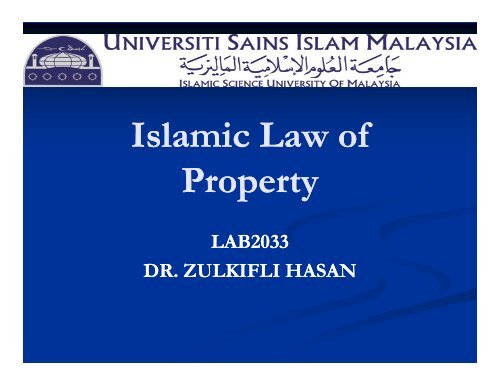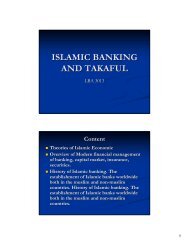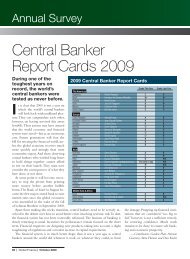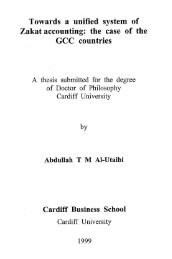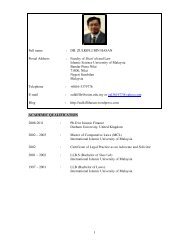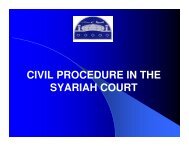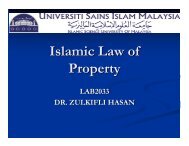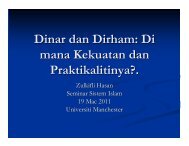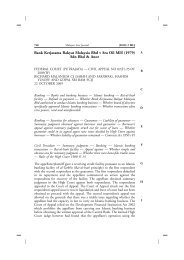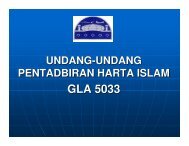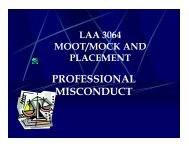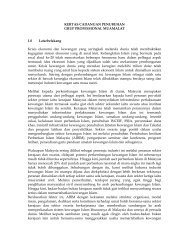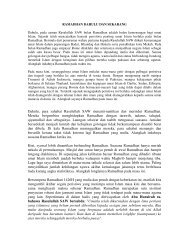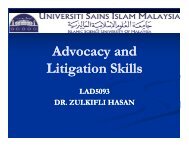Harta sepencarian
Harta sepencarian
Harta sepencarian
Create successful ePaper yourself
Turn your PDF publications into a flip-book with our unique Google optimized e-Paper software.
Islamic Law ofPropertyLAB2033DR. ZULKIFLI HASAN
<strong>Harta</strong> Sepencarian Conceptual FrameworkContent The Practice of <strong>Harta</strong> Sepencarian
Introduction <strong>Harta</strong> <strong>sepencarian</strong>-urfor adat HS as harta syarikat or partnershipproperty.
Definition S 2 of the IFLFT 1984: Property jointlyacquired by the husband and wife during thesubsistence of marriage in accordance withthe conditions stipulated by Hukum syarak. It is due to the joint effort or joint labourthat a divorced spouse is entitled to a sharein the property. N.9: Carian laki bini Selangor: directly or indirectly
Conceptual Basis Fuqaha views Syarikat al Abdan Al adah al muhakkamah Fatwa Cases
Al Umm When a dispute occurs btn man and woman inregard to articles or household furniture in theirhousehold a result of their divorce or eventhough not separated or both H and W die orone of them dies, and in the situation whereboth H and W die or one of the two of themdies, a dispute arises among the heirs on bothsides, or among the heirs on one of the twosides, the method for resolution in all cases isthe same.
The Bughyah at-Mustarsyidin“When the property of a husband and wife has merged and it is not knownwhose property is more, there are no signs to differentiate the propertyfrom one to the other, and then divorce or death occurs between the two, itis therefore unlawful for one or both (spouses or heir) to rule over (utilise)part of the property before it can be differentiated or before conciliation (al-sulh) unless together with the owner because there is no murajjih (signs todifferentiate). As they say, if the pigeons of the spouses are mixed and atthat instance, is known or differentiated between the two, but if it is notknown and cannot be differentiated, the issue must be postponed until thehusband or the heirs both make peace or delivers (hibah) equally orapproximately if they (spouses) and heirs are good people (not mahjura’laihi) and it is compulsory not to lessen (people who are not allowed toadminister property). But if it is normal and consistent that one of the two(spouses) has more income than the other, conciliation (sulh) anddeliverance (hibah) is based on that (approximate). If they do not agree toeither of these, the party which owns something from the property (holdsthe property) will have their statement accepted under oath; that theproperty is theirs.
Syarikat Al Abdan Syarikat al-Abdanis the means of two peoplesharing an occupation with each onecontributing his/her energy without anyproperty or capital. all properties acquired from the work ofhusband and wife which cannot be distinguishedare divided between the two according to areasonable wage and should one of them orboth die, the heirs of the deceased from bothwill take the portions that they receive to bedivided according to faraid.
Al-A’adahA’adah Muhakkamah Islam acknowledges that custom, eitherspecifically or generally, is one of the sources ofIslamic Law and a custom can be accepted whenit becomes common usage and the norm
Fatwa Terengganu: “<strong>Harta</strong> yang menjadi hak milik khas bagi suami atau bagiisteri maka harta itu tidakalah mesti dibahagi, masing-masingmengambil haknya, adapun harta yang diperolehi sebagai hasildari usaha dan pencarian bersama maka itulah yang wajibdibahagi menurut kadar sumbangan tenaga yang diberi olehmasing-masing untuk mendapatkan keuntungan (harta baru)dengan tidak menghiraukan modalnya oleh suami atau isteri
Sh ct’s Decision Semek v Siti Zubaidah (1995) 11 JH 153 Awang Abd Rahman v Shamsuddin Awand dan SatuLagi (1977) 11 JH 193 Piah bt. Said v Che Lah bin Awang(1983) 3 JH220 Boto v Jaafar (1985) 2 MLJ 98
Awang Abd Rahman v Shamsuddin Awanddan Satu Lagi (1977) 11 JH 193 The pt made an application to the Sh ct for anorder that a parcel of land that was registered inthe name of his stepfather was HS of hisdeceased mother. Held: the ct found no evidence to prove that theland was HS. The ct however reaffirmed that HSis a malay adat that is recognised under hukumsyarak.
Boto v JaafarJaafar (1985) 2 MLJ 98 The W giving up her employment after themarriage and accompanying her H on his severalbusiness trips. Divorce-Applied for HS. Salleh Abas: the above sacrifice must amount tojoint efforts in the acquisition of the properties. The W constant companionship was responsiblefor the H’s peace of mind. The W isautomatically entitled to one-third share in theproperties acquired during the marriage.
Piah bt. Said v Che Lah bin Awang(1983) 3 JH220 Kadi Besar Pulau Pinang Hj. Harussani bin Hj.Zakaria: <strong>Harta</strong> yang diperolehi bersama-samasuami isteri ituhidup bersama dan berusaha, sama ada kedua-duapasanagan itu sama-samabekerja dalam bidang yangsama atau dalam bidang yang berlainan dan sama adasecara rasmi atau tidak rasmi sama ada dibahagikantugas atau tidak”.
Semek v Siti Zubaidah (1995) 11 JH 153 The Pt had married Yasim in 1950 and ended ina divorce in 1982. In 1991, Yasim died leaving 3children, the Dts. The Pt claimed for HS for 3parcels of land. SHC: Although the term HS is not expresslymentioned in Islamic law, it is a malay customerand one that brings benefit to women. It has aplace in hukum syarak within the concept ofupah. When a W carries out her duties at homein excess of her duties stipulad in hukum syarakshe must given compensation.
Court’s Jurisdiction S 61 (3) (b) (iv) AILSE 2003: A sh ct shall in its civil jurisdiction determine allactions and proceedings in which all the partiesare muslims and which relate to .. The divisionof and claims to, harta <strong>sepencarian</strong>.
When? 1) Divorce 2) Death 3) Polygamy
Divorce S 122 (1): sh ct has power when permitting thepronouncement of talaq, or when making anorder of divorce to order the division btn theparties or any asset required by them during themarriage by their joint efforts. Roberts v Umi Kalthom (1966) 1 MLJ 163 Boto v Jaafar (1985) 2 MLJ 98 Noor Bee v Ahmad Shanusi (1978) 1 JH 63 Zainuddin v Anita (1980) 4 JH 3
Tijah v Mat Ali [1884] 4 KY 124 The parties- jointly rented lands and planted padi andmade nipah sugar. The proceeds from the sale werepartly utilised for household expenses, the remainderbeing kept by the H. Divorce: the W sued for RM50- half-shareshare- balance ofjoint earnings. Ct: qadhi gave expert evidence- the W is entitled to ahalf-share of all property acquired by the joint earningsof H and W during coverture. HS to the W. Appeal: earning of the spouses during coverturebelonged to the H unless the MMO 1880 providedo/wise.
Hujah Lijah v Fatimah (1950) MLJ 63 HS is a branch of Malay adat. Recognisedthroughout kelantan. The W got one-half apart from her claim to theestate.
Death No specific provision under the IFL enactment. S 2 of IFLS 2003: The right can be claimed onthe basis of malay custom and Hukum syarak. The ct may grant orders of HS arising from thedeath of a spouse.
Hajah Saudah v Hanafi & Ors (1990) 9JH 198 The Pt-former W of HJ Daud claimed for HS-the deceased’s land. Qadhi: there was qarinah to prove that the landwas HS property. Appeal: the Pt took solemn oath and HS wasgranted.
Bunga Ibrahim v Ila Abdullah(1990) 9 JH 198 The Pt had been married to the Deceased for 36yrs. She claimed for HS. The ct besar of qadhi granted an application fora share in the estate of her deceased’s H as HS.
Haji Ramah v Alpha & Ors (1924)4 FMSLR 179 The W claimed her share-faraid- a further halfshare in the 2 pieces of land bcoz she helped herH in opening and cultivating them. The Ct: Should apply Islamic law. Qadhi: expert evidence. The widow was entitledto one-quarter of the value of land which shehad helped to cultivate as upah or compensationfor work done in addition to her quarter share inthe estate.
Wan Junaidah v Latiff (1988) 8 JH 122 Divorce-The W claimed inter alia for a share ofHS being half of the proceeds of the sale ofland- RM57310. Held: the pt was entitled to share the HS.
Polygamy S 23 (10) Every Court that grants the permissionor orders the marriage to be registered underthis section shall have the power on theapplication by any party to the marriage (a) to require a man to pay maintenance to hisexisting wife or wives; or (b) to order the division between the parties ofthe marriage of any assets acquired by themduring the marriage by their joint efforts or thesale of any such assets and the division of theproceeds of the sale.
HS and EPF 1) EPF as HS 2) EPF as an estate
Timah Sulaiman v Abd Rahman Ayob (2001)JH XIV 297 The pt applied for mutaah and HS arising froma divorce. HS-bungalow at PD, a car and thesaving in the Epf. Wtr the Pt had provided sufficient proof toshow that the properties were HS. SHC N.9: the car and EPF money were HS.Efforts+ managed the household withoutassistance. The pt was entitled to get one-thirdof the EPF. SCOA: The EPF was an estate and not HS.
Che Mas Abdullah v Mat Sharie YaakubNo-41-001-8-99 17.4.2003 A divorced pt brought a claim for HS in the sumof RM36k (EPF of her H). SHC Tganu: Only the aggregate deductions of the member salaryfor payment to the EPF- HS The employers contribution and dividends: estate Lack of evidence: the claim for HS thereby failed.
Division of HSS 122. (1) The Court shall have power, when permitting thepronouncement of talaq or when making an order of divorce, toorder the division between the parties of any assets acquired bythem during their marriage by their joint efforts or the sale ofany such assets and the division between the parties of theproceeds of sale.(2) In exercising the power conferred bysubsection (1), the Court shall have regard to—(a) the extent of the contributions made by each party inmoney, property, or labour towards acquiring of the assets;(b) any debts owing by either party that were contracted fortheir joint benefit;(c) the need of the minor children of the marriage, if any, and,subject to those considerations, the Court shall incline towardsequality of division.
1. One-third 2. one halfApproaches The court will look at the contribution ofboth parties. Joint effort or sole effort
One-third If the W’s contribution is in an indirect form Boto v Jaafar (1985) 2 MLJ 98 Rokiah v Mohd Idris (1989) 3 MLJ
One half If the W has directly contributed to theacquisition of the properties Wan Junaidah v Latiff (1988) 8 JH 122 Hj Abd Rahim v Isngaton (1980) 2 JH


